Goutam Saha
IITKGP-ABSP Submission to LRE22: Language Recognition in Low-Resource Settings
Jan 15, 2025Abstract:This is the detailed system description of the IITKGP-ABSP lab's submission to the NIST language recognition evaluation (LRE) 2022. The objective of this LRE (LRE22) is focused on recognizing 14 low-resourced African languages. Even though NIST has provided additional training and development data, we develop our systems with additional constraints of extreme low-resource. Our primary fixed-set submission ensures the usage of only the LRE 22 development data that contains the utterances of 14 target languages. We further restrict our system from using any pre-trained models for feature extraction or classifier fine-tuning. To address the issue of low-resource, our system relies on diverse audio augmentations followed by classifier fusions. Abiding by all the constraints, the proposed methods achieve an EER of 11.43% and cost metric of 0.41 in the LRE22 development set. For users with limited computational resources or limited storage/network capabilities, the proposed system will help achieve efficient LID performance.
Practicality meets precision: Wearable vest with integrated multi-channel PCG sensors for effective coronary artery disease pre-screening
Sep 09, 2024



Abstract:The leading cause of mortality and morbidity worldwide is cardiovascular disease (CVD), with coronary artery disease (CAD) being the largest sub-category. Unfortunately, myocardial infarction or stroke can manifest as the first symptom of CAD, underscoring the crucial importance of early disease detection. Hence, there is a global need for a cost-effective, non-invasive, reliable, and easy-to-use system to pre-screen CAD. Previous studies have explored weak murmurs arising from CAD for classification using phonocardiogram (PCG) signals. However, these studies often involve tedious and inconvenient data collection methods, requiring precise subject preparation and environmental conditions. This study proposes using a novel data acquisition system (DAQS) designed for simplicity and convenience. The DAQS incorporates multi-channel PCG sensors into a wearable vest. The entire signal acquisition process can be completed in under two minutes, from fitting the vest to recording signals and removing it, requiring no specialist training. This exemplifies the potential for mass screening, which is impractical with current state-of-the-art protocols. Seven PCG signals are acquired, six from the chest and one from the subject's back, marking a novel approach. Our classification approach, which utilizes linear-frequency cepstral coefficients (LFCC) as features and employs a support vector machine (SVM) to distinguish between normal and CAD-affected heartbeats, outperformed alternative low-computational methods suitable for portable applications. Utilizing feature-level fusion, multiple channels are combined, and the optimal combination yields the highest subject-level accuracy and F1-score of 80.44% and 81.00%, respectively, representing a 7% improvement over the best-performing single channel. The proposed system's performance metrics have been demonstrated to be clinically significant.
Wavelet Scattering Transform for Improving Generalization in Low-Resourced Spoken Language Identification
Oct 03, 2023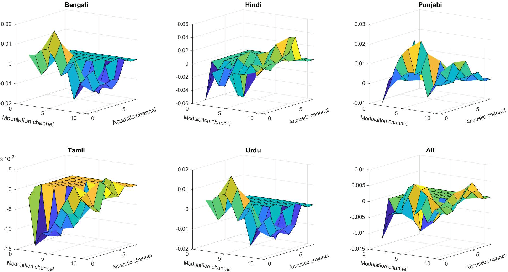

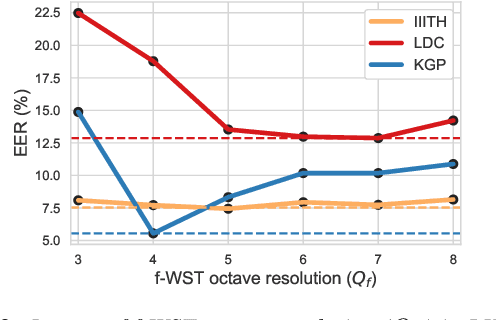

Abstract:Commonly used features in spoken language identification (LID), such as mel-spectrogram or MFCC, lose high-frequency information due to windowing. The loss further increases for longer temporal contexts. To improve generalization of the low-resourced LID systems, we investigate an alternate feature representation, wavelet scattering transform (WST), that compensates for the shortcomings. To our knowledge, WST is not explored earlier in LID tasks. We first optimize WST features for multiple South Asian LID corpora. We show that LID requires low octave resolution and frequency-scattering is not useful. Further, cross-corpora evaluations show that the optimal WST hyper-parameters depend on both train and test corpora. Hence, we develop fused ECAPA-TDNN based LID systems with different sets of WST hyper-parameters to improve generalization for unknown data. Compared to MFCC, EER is reduced upto 14.05% and 6.40% for same-corpora and blind VoxLingua107 evaluations, respectively.
Cross-Corpora Spoken Language Identification with Domain Diversification and Generalization
Feb 10, 2023



Abstract:This work addresses the cross-corpora generalization issue for the low-resourced spoken language identification (LID) problem. We have conducted the experiments in the context of Indian LID and identified strikingly poor cross-corpora generalization due to corpora-dependent non-lingual biases. Our contribution to this work is twofold. First, we propose domain diversification, which diversifies the limited training data using different audio data augmentation methods. We then propose the concept of maximally diversity-aware cascaded augmentations and optimize the augmentation fold-factor for effective diversification of the training data. Second, we introduce the idea of domain generalization considering the augmentation methods as pseudo-domains. Towards this, we investigate both domain-invariant and domain-aware approaches. Our LID system is based on the state-of-the-art emphasized channel attention, propagation, and aggregation based time delay neural network (ECAPA-TDNN) architecture. We have conducted extensive experiments with three widely used corpora for Indian LID research. In addition, we conduct a final blind evaluation of our proposed methods on the Indian subset of VoxLingua107 corpus collected in the wild. Our experiments demonstrate that the proposed domain diversification is more promising over commonly used simple augmentation methods. The study also reveals that domain generalization is a more effective solution than domain diversification. We also notice that domain-aware learning performs better for same-corpora LID, whereas domain-invariant learning is more suitable for cross-corpora generalization. Compared to basic ECAPA-TDNN, its proposed domain-invariant extensions improve the cross-corpora EER up to 5.23%. In contrast, the proposed domain-aware extensions also improve performance for same-corpora test scenarios.
Modulation spectral features for speech emotion recognition using deep neural networks
Jan 14, 2023Abstract:This work explores the use of constant-Q transform based modulation spectral features (CQT-MSF) for speech emotion recognition (SER). The human perception and analysis of sound comprise of two important cognitive parts: early auditory analysis and cortex-based processing. The early auditory analysis considers spectrogram-based representation whereas cortex-based analysis includes extraction of temporal modulations from the spectrogram. This temporal modulation representation of spectrogram is called modulation spectral feature (MSF). As the constant-Q transform (CQT) provides higher resolution at emotion salient low-frequency regions of speech, we find that CQT-based spectrogram, together with its temporal modulations, provides a representation enriched with emotion-specific information. We argue that CQT-MSF when used with a 2-dimensional convolutional network can provide a time-shift invariant and deformation insensitive representation for SER. Our results show that CQT-MSF outperforms standard mel-scale based spectrogram and its modulation features on two popular SER databases, Berlin EmoDB and RAVDESS. We also show that our proposed feature outperforms the shift and deformation invariant scattering transform coefficients, hence, showing the importance of joint hand-crafted and self-learned feature extraction instead of reliance on complete hand-crafted features. Finally, we perform Grad-CAM analysis to visually inspect the contribution of constant-Q modulation features over SER.
* Accepted for publication in Elsevier's Speech Communication Journal
An Overview of Indian Spoken Language Recognition from Machine Learning Perspective
Nov 30, 2022Abstract:Automatic spoken language identification (LID) is a very important research field in the era of multilingual voice-command-based human-computer interaction (HCI). A front-end LID module helps to improve the performance of many speech-based applications in the multilingual scenario. India is a populous country with diverse cultures and languages. The majority of the Indian population needs to use their respective native languages for verbal interaction with machines. Therefore, the development of efficient Indian spoken language recognition systems is useful for adapting smart technologies in every section of Indian society. The field of Indian LID has started gaining momentum in the last two decades, mainly due to the development of several standard multilingual speech corpora for the Indian languages. Even though significant research progress has already been made in this field, to the best of our knowledge, there are not many attempts to analytically review them collectively. In this work, we have conducted one of the very first attempts to present a comprehensive review of the Indian spoken language recognition research field. In-depth analysis has been presented to emphasize the unique challenges of low-resource and mutual influences for developing LID systems in the Indian contexts. Several essential aspects of the Indian LID research, such as the detailed description of the available speech corpora, the major research contributions, including the earlier attempts based on statistical modeling to the recent approaches based on different neural network architectures, and the future research trends are discussed. This review work will help assess the state of the present Indian LID research by any active researcher or any research enthusiasts from related fields.
* Accepted for publication in ACM Transactions on Asian and Low-Resource Language Information Processing
Analysis of constant-Q filterbank based representations for speech emotion recognition
Nov 29, 2022Abstract:This work analyzes the constant-Q filterbank-based time-frequency representations for speech emotion recognition (SER). Constant-Q filterbank provides non-linear spectro-temporal representation with higher frequency resolution at low frequencies. Our investigation reveals how the increased low-frequency resolution benefits SER. The time-domain comparative analysis between short-term mel-frequency spectral coefficients (MFSCs) and constant-Q filterbank-based features, namely constant-Q transform (CQT) and continuous wavelet transform (CWT), reveals that constant-Q representations provide higher time-invariance at low-frequencies. This provides increased robustness against emotion irrelevant temporal variations in pitch, especially for low-arousal emotions. The corresponding frequency-domain analysis over different emotion classes shows better resolution of pitch harmonics in constant-Q-based time-frequency representations than MFSC. These advantages of constant-Q representations are further consolidated by SER performance in the extensive evaluation of features over four publicly available databases with six advanced deep neural network architectures as the back-end classifiers. Our inferences in this study hint toward the suitability and potentiality of constant-Q features for SER.
* Accepted for publication in Elsevier's Digital Signal Processing Journal
Robust Acoustic Domain Identification with its Application to Speaker Diarization
Aug 08, 2022Abstract:With the rise in multimedia content over the years, more variety is observed in the recording environments of audio. An audio processing system might benefit when it has a module to identify the acoustic domain at its front-end. In this paper, we demonstrate the idea of \emph{acoustic domain identification} (ADI) for \emph{speaker diarization}. For this, we first present a detailed study of the various domains of the third DIHARD challenge highlighting the factors that differentiated them from each other. Our main contribution is to develop a simple and efficient solution for ADI. In the present work, we explore speaker embeddings for this task. Next, we integrate the ADI module with the speaker diarization framework of the DIHARD III challenge. The performance substantially improved over that of the baseline when the thresholds for agglomerative hierarchical clustering were optimized according to the respective domains. We achieved a relative improvement of more than $5\%$ and $8\%$ in DER for core and full conditions, respectively, on Track 1 of the DIHARD III evaluation set.
Cross-Corpora Language Recognition: A Preliminary Investigation with Indian Languages
May 12, 2021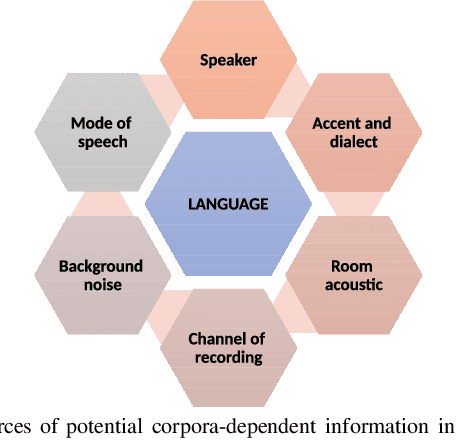
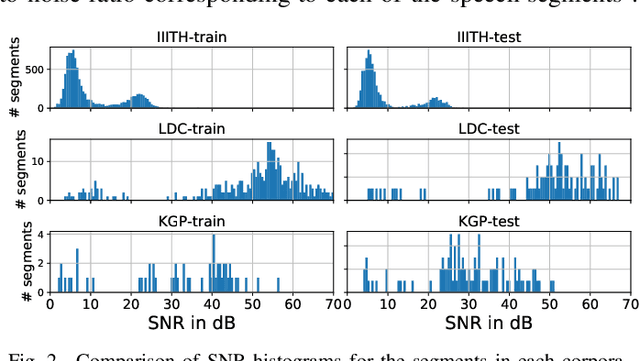
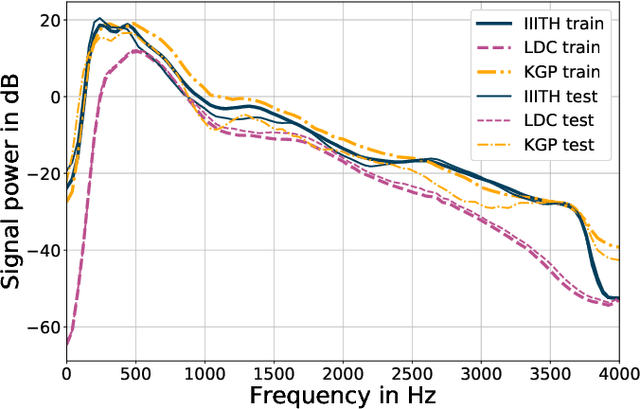
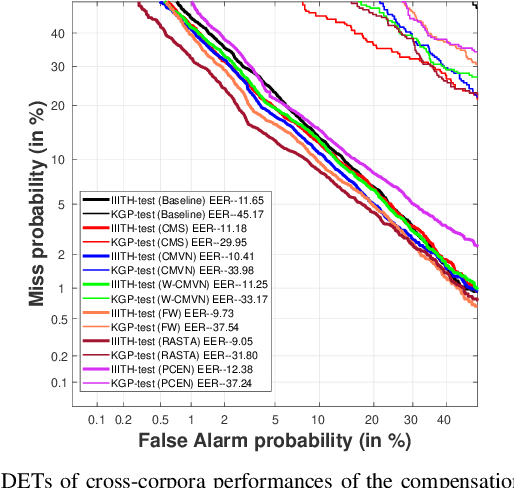
Abstract:In this paper, we conduct one of the very first studies for cross-corpora performance evaluation in the spoken language identification (LID) problem. Cross-corpora evaluation was not explored much in LID research, especially for the Indian languages. We have selected three Indian spoken language corpora: IIITH-ILSC, LDC South Asian, and IITKGP-MLILSC. For each of the corpus, LID systems are trained on the state-of-the-art time-delay neural network (TDNN) based architecture with MFCC features. We observe that the LID performance degrades drastically for cross-corpora evaluation. For example, the system trained on the IIITH-ILSC corpus shows an average EER of 11.80 % and 43.34 % when evaluated with the same corpora and LDC South Asian corpora, respectively. Our preliminary analysis shows the significant differences among these corpora in terms of mismatch in the long-term average spectrum (LTAS) and signal-to-noise ratio (SNR). Subsequently, we apply different feature level compensation methods to reduce the cross-corpora acoustic mismatch. Our results indicate that these feature normalization schemes can help to achieve promising LID performance on cross-corpora experiments.
Deep scattering network for speech emotion recognition
May 11, 2021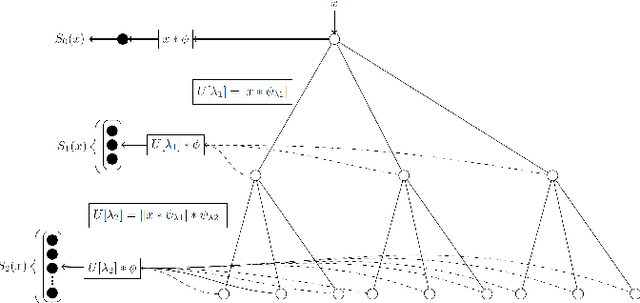
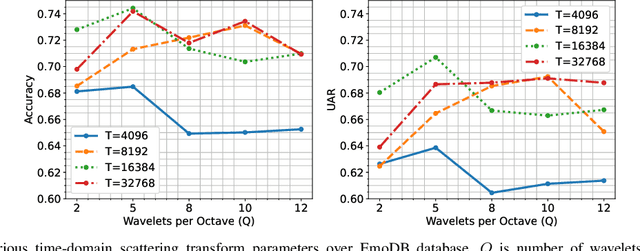
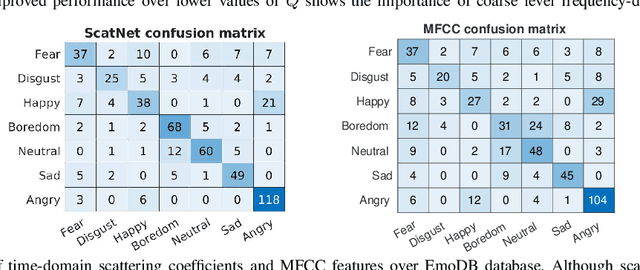
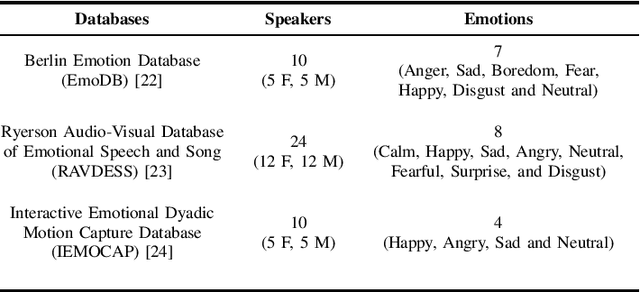
Abstract:This paper introduces scattering transform for speech emotion recognition (SER). Scattering transform generates feature representations which remain stable to deformations and shifting in time and frequency without much loss of information. In speech, the emotion cues are spread across time and localised in frequency. The time and frequency invariance characteristic of scattering coefficients provides a representation robust against emotion irrelevant variations e.g., different speakers, language, gender etc. while preserving the variations caused by emotion cues. Hence, such a representation captures the emotion information more efficiently from speech. We perform experiments to compare scattering coefficients with standard mel-frequency cepstral coefficients (MFCCs) over different databases. It is observed that frequency scattering performs better than time-domain scattering and MFCCs. We also investigate layer-wise scattering coefficients to analyse the importance of time shift and deformation stable scalogram and modulation spectrum coefficients for SER. We observe that layer-wise coefficients taken independently also perform better than MFCCs.
 Add to Chrome
Add to Chrome Add to Firefox
Add to Firefox Add to Edge
Add to Edge